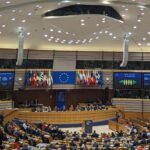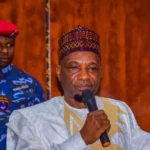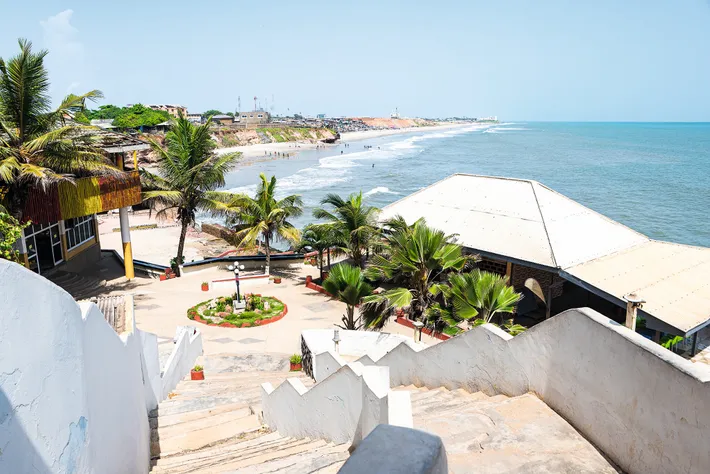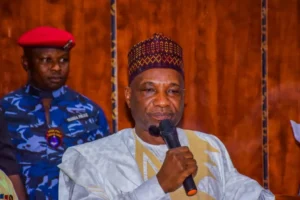Ghana’s beachside capital has become one of the most exciting places in Africa for artists and grassroot creative enterprises, with studios and galleries filling the gaps between raucous clubs and bustling markets.
The road past Makola Market is swarming with hawkers. Pavements are littered with leather goods. Women wrapped in hand-loomed fabrics step into the street, balancing giant tubs of kpakpo shito peppers on their heads. Hip-hop blasts from a distant speaker. A preacher delivers a sermon into a megaphone.
Beside me, in the driver’s seat, Selasie Gomado is inching along to the petrol station. An hour ago, he picked me up for a visit to Artemartis, the artists’ collective he runs west of the city centre, but in that time we’ve progressed barely a mile. After damaging a tyre on a pothole, Selasie flagged down a guy on the roadside to repair it. A policeman stopped us at a barricade for a routine check of the boot. Then, as we crawled down a narrow residential street, a cyclist in a long, white, embroidered boubou teetered into the bumper and toppled in dramatic fashion, prompting a brief detour to the hospital. He was fine; Selasie was frazzled.
More than four million people live in the Greater Accra Metropolitan Area, and life here serves up daily obstacles, which is what makes Selasie’s business such a feat. The blue-painted breezeblock cottage is part-workshop, part-gallery and part-crash-pad, providing emerging artists with studio space, supplies, management, hype and, crucially, time to experiment with mediums and concepts. Canvases thick with saturated colour and emotion hang from the walls in various stages of completion, echoing the chaos outside.
In the five years since launching Artemartis, Selasie has watched his artists develop in tandem with a city-wide art boom. Galleries like his have multiplied and flourished. Nurturing curators have coaxed spirited work from the grassroots and boosted the reputation of Ghanaian art worldwide. “The scene is growing,” says Selasie. “The number of people attending exhibitions is growing. Collectors are growing.”
The noise has reverberated far beyond this sliver of West Africa. Papered across the main space at Artemartis are portraits by James Mishio of dreadlocked men serving devastating stares. James’s work is layered with fabric — he creates the characters’ dapper outfits and applies them to the canvases — and layered with meaning. Even the viscous acrylic paint is designed to be symbolic of the stigma men endure for their hair or skin. Already his work has landed in the hands of London buyers.
There’s an abundance of creativity within Accra. In a city burdened by the legacy of slavery, colonialism, dysfunction and poverty, art is a beautifully poignant way of learning about the struggle and the scars.
The work by Accra’s newest art darling, Araba Opoku, is a case in point. When we meet at Artemartis, she tells me about the region’s ongoing water crisis, which at one point forced her family to live nocturnally, waking at midnight to collect water in buckets while the taps flowed. In a new abstract series, Araba used diluted acrylics to convey the physical and psychological toll of that time, “but also the joy and satisfaction in that struggle,” she says. “That [paradox] is a universal theme in art around the city.”
Araba’s series was commissioned by Gallery 1957, one of the world’s most important spaces dedicated to West African artists. When we leave Artemartis, she takes me to one of its three gallery spaces in the city.
Along the way, I see more evidence that art is part of the fabric of Accra: it’s in the naive murals on school walls and the hand-drawn billboards for shrimp seasoning. At the Centre for National Culture, also known as the Arts Centre, a grid of stalls spread across the seafront, artisans crouch over ziggurat beadwork. In Jamestown, the 400-year-old quarter occupied at various times by the Portuguese, the Dutch and the British, a basketball court is painted like an Ellsworth Kelly colour field.
Many of Ghana’s young artists found their voices in the years leading up to the Covid pandemic. Some used social media to amplify their work, defying traditional attitudes against art as a legitimate profession. A burgeoning upper-middle class emerged to appreciate local talent. New galleries abroad exhibiting Ghanaian works opened Western eyes to artists who’d been germinating for years. Then, in 2019, there came a boost in the form of the Year of Return, a government initiative aimed at encouraging the African diaspora to come to Ghana and helping to increase interest in local art.
Even before all that, in 2016, a Lebanese emigré called Marwan Zakhem started a mini-revolution with the opening of Gallery 1957, named for Ghana’s year of independence from Britain. In a city that had previously had no major art museums, Gallery 1957 became a beacon.
The gallery is located between the bustling Makola Market and the statuesque arches in Black Star Square, in a compound of pristine buildings and freshly mowed lawns that starkly contrast with gardens elsewhere, tended by roaming goats. As Araba and I float between rooms, I’m riveted by the graphic interpretations of ancient motifs; by photographs depicting domestics as Renaissance noblewomen, breasts sewn together from coconut husks; and by Araba’s rippling, watery visions.
And yet, she tells me, there’s a general belief “that art inside the country isn’t as fulfilling as what’s outside.” Having made potentially perilous career choices, these artists are desperate to be seen. “But it’s hard to stand out when nobody takes the time to understand our work,” she says. “And people who are interested don’t know where to see it. But that’s starting to change.”
Changing the narrative
“Everything is art here,” says Godfried Donkor, an old-guard artist whose collages of Ghanaian boxers with gold Renaissance halos command attention at Gallery 1957. I’ve navigated the broken pavements to meet him at his table outside ABC, a tiny pub carved from the living room of a local seamstress. The graphic mural painted on the stucco facade is photo-worthy, but Godfried is more inspired by the schoolchildren in pale-blue uniforms skipping past and by the extended family emerging from a tiny, beat-up taxi like clowns from a Mini. He’s especially inspired by the sports stadium across Starlets 91 Road.
“The light is amazing for painting,” he says. “At dusk, just before 4pm, it’s transformative.”
It was here, in 2010, that Godfried watched a rainbow materialise after a summer shower before rushing home to paint Madonna in Red & Rainbow. Ever since, ABC has become his de facto salon, where he still drinks bottles of cheap Club lager, even as collectors are snapping up his work.
Godfried was one of the first Ghanaian contemporary artists recognised internationally — not as an ‘African artist’, but as an artist full stop. Yet the scene is changing, he tells me. “The context of art in terms of a ‘gallery space’ is only recent,” he says. “Now, all of a sudden, art has become fashionable and cool because of the exposure, because artists have the time and space to make more ambitious works. And the youngsters are into it.”
The urban landscape has responded to the desire to live creatively around the clock. Accra’s first member’s club, Front/Back, exhibits up-and-comers to an exclusive, deep-pocketed clientele indoors and to the wider public in a dedicated space outside. And in a contemporary tower uptown, there’s Skybar 25, a bacchanalian rooftop terrace with a pool and panoramic views distorted by the dense, humid air.
Godfried can occasionally be found at Front/Back, but is too tired to join when I’m swept up in a group headed to Sky Bar that evening. It’s just as well, as I can barely hear above the thumping hip-hop. But there’s plenty to look at. The Ghanaian tradition of dressing for impact is thriving here: among the revellers, there are elegantly draped fabrics, box-fresh Gucci trainers and six-inch heels. Hair is big and bold, skin noticeably unsweaty. Everyone seems to know everyone else, and I’m introduced to Adora Mba, an African-art specialist who runs the ADA Contemporary Art Gallery downstairs.
Adora conceived the idea as a corrective in an industry where the “gatekeepers,” as she describes them, “tend to be Caucasian Westerners — people who don’t know my home discussing our narrative, our work. I wanted to be the person doing it authentically.” She sees her job as promoting and protecting young artists.
In only three years, she’s witnessed a shift in what’s deemed ‘Black art’ from portraiture to more abstract, multifaceted work, and has seen the global gaze settle on Ghana. Suddenly, ADA Contemporary Art Gallery is a key stop on the international art trail. “I’ve always had to travel to New York, Paris, London to see gallerists,” Adora says. “And for the first time, they’re coming here — major institutions, gallerists I look up to… we’re now a place people want to come to. It’s not considered strange.”
On my way out, I take the lift down and peer into the gallery, spotting minimalist paintings by Nigerian artist Deborah Segun, her graphic, voluptuous, female figures clutching one another in grief and support. I feel incredibly buoyed by the use of exuberant candy colours as a symbol of joy and satisfaction in the midst of struggle.
Even as a tourist, I can understand the premise. On my last morning in town, I walk along dusty roads flanked by deep, open gutters to the old township of Labadi. On the stoops of ramshackle hair salons and phone shops, mothers try to keep their babies cool beneath corrugated roofs. Men in football shirts push wheelbarrows of coconuts. A roadside kiosk displays dummy legs and buxom torsos, but no fashion for them to wear. For much of the population, life is gruelling and never stops. Yet nowhere is without colour, music and casual camaraderie.
In Labadi, I stop for coconut rice and vegetable stew at Palm Moments, a breezy cafe in a residential quarter populated by artist studios. Ten minutes down the road, behind an embellished stone wall, is where local superstar Amoako Boafo shows his provocative figurative art. Faces rendered in thick, finger-worked oils stare out powerfully from chipped walls dappled with light from the garden. The space is so quiet I can hear a cyclist pass outside.
I hail a taxi and we listen, dissonantly, to Kenny Rogers on country radio while fighting rush hour traffic en route to the thronging alleyway where Serge Attukwei Clottey keeps a studio. To make his epic, multicoloured wall-hangings, the self-taught artist and sculptor has cut hundreds of plastic squares out of petrol jerrycans, then assembled them like patchwork quilts. Dangling from the ceiling, they create a sort of viewing maze.
It’s now almost 5pm and being this close to the equator means there isn’t much daylight left, so I hightail it to the beach. Ozzie’s Beach Palace is a quiet terrace with tiki umbrellas, rattan chairs and mellow jazz. I grab a cold beer for a pound in a bar area crammed with canvases and local crafts, then kick off my shoes and pad down to the tide.
The wind smacks me in the face and I turn to see a lanky teen riding on horseback across the sand. He trots around me, giggles, then carries on over the rocks. As a parting moment, it’s artful, cinematic, meme-able, memorable: a proper work of art.
Insider tips
Accra’s Pan African Heritage Museum is set to open later this year on a plateau north of Makola Market. It will house a theatre, library and galleries featuring art, crafts and artefacts from the great civilisations in Africa going back centuries. You can combine a visit with a tour of the nearby National Museum of Ghana, a showcase of archaeological finds.
Don’t get your Jamestowns venues mixed up — more than one Accra business has borrowed the neighbourhood name. Jamestown Coffee Company in Osu is a bright, breezy lunch spot where the bartender makes a refreshing sangria (virgin or acoholic) with sobolo, the local hibiscus juice. Jamestown Café, on the other hand, is a social club near Ussher Fort that has live music and lively lunches on Sunday afternoons.
For inspiration for your visit, listen online to the independent station Oroko Radio, which broadcasts West African beats, gospel, soul and DJ sets from Fake Fridays at Palm Moments.
Q&A with Carina Tenewaa Kanbi, co-founder of AYA Editions
How are women in the arts being supported in Accra?
We’re seeing more spaces now where artists are nurtured, like the Nubuke Foundation, which showcases a lot of female artists. The online network Trybe Africa hosts a showcase of female talent the first Thursday of every month at Kukun, a cafe in Osu.
Where can visitors find female artists in Accra?
Female DJs often spin at Palm Moments, which also does a big Thursday-night party called Fake Fridays. Also Terra Alta, run by the artist Elisabeth Sutherland. The incredible Freedom Skatepark just signed an agreement with Spotify to create a practice studio for female DJs.
Where are the best craftswomen found?
For a range of fashion and souvenirs, check out the women-run crafts market held on the last Saturday of every month at the W.E.B. DuBois Centre (make sure to bring cash). And you can’t skip Makola Market, where the traders are predominantly women.
AYA Editions is a platform dedicated to educating West African female artists and selling their work.
Getting around
It’s easy and safe to walk around Accra, but distances can be long and days are hot. Uber and Bolt taxis are common, but drivers prefer cash payments, so toggle your app in the Help section. Taxis are easy to flag, too. Pay in the local cedi or in US dollars. Download an offline map of the city so you can show the driver your live location if they ask. Trips within Accra usually cost no more than a couple of dollars.
When to go
August is the coolest month in Accra, with average daytime temperatures of 23C to 27C. It’s also the month of the Chale Wote Street Art Festival, when art and performance infiltrate every neighbourhood. Avoid the dry season, November to March, when Saharan winds coat the city in grit.
Source: nationalgeographic











